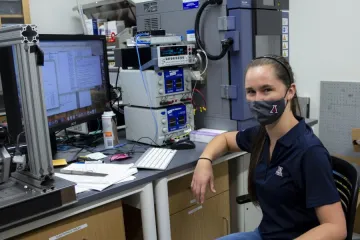Another Wavelength: Kelsea Cronin

This month in Another Wavelength, we chat with 5th year Ph.D. Student Kelsea Cronin, currently mentored by Professor Lars Furenlid.
Where are you from?
I am originally from Albuquerque, New Mexico.
What brought you to study optics?
My research advisor in Undergrad (at New Mexico Institute of Mining and Technology) introduced me to the field of optics and encouraged me to apply to optics grad school programs.
Who is your hero in science?
Marie Curie is my science hero. Her story fascinates me because of her struggles as a female scientist as well as the warning it offers on the dangers of science. I think its important to remember that even with the best intentions you can end up discovering dangerous and terrible things.
Describe your research in 20 words or fewer.
I am designing and building a small animal multi-technology preclinical SPECT (Single photon emission computed tomography) device.
Describe your research in 200 words or fewer.

There are many challenges in SPECT (Single photon emission computed tomography) imaging because of the fundamental tradeoffs inherent in the detector physics. By combining multiple detector types some of these limitations can be mitigated. I started my work by modeling a system with multiple detectors with different SPECT configurations to compare it to systems with one of these SPECT technologies. This simulation provides a quantitative way to evaluate each detectors advantages and weaknesses as standalone systems and as an integrated system. From this work I have determined an optimized imager for high energy and spatial resolution without sacrificing sensitivity or field of view. This design involves integrating two different SPECT detector types: the quantum imaging detector (iQID) and a CdTe crossed-strip semiconductor detector. The iQID scintillation detector can achieve excellent spatial resolution while also delivering high sensitivity, but with limited energy resolution. This compliments the semiconductor detector's ability to achieve excellent energy and spatial resolution, but at limited count rates and with a smaller detector area. My current work is designing and constructing the combined imaging device into a rotating gantry imager. The end design will be used to image rodents over a range of high energies.
Name three neat facts about you.
- I have visited all 50 states on various vacations.
- I compete in triathlons (run, bike and swim) in my free time as well as running races and cycling events.
- I lived in Ireland when I was younger.
